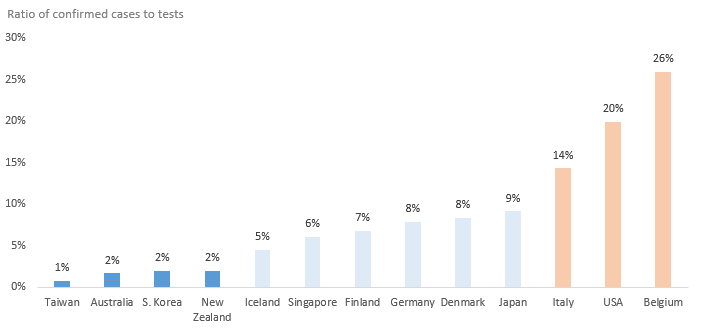Other Insights
Coronavirus Pandemic: Who has Responded Best?
Determining the success of a country’s response to COVID-19 is a complicated calculation. Headline metrics like the total number of infections are nearly meaningless without context. Not all countries are created equally. Some are sparsely populated, others have higher incomes, and a few are remote islands away from population centers. Even if governments reacted in the same way, these other factors would conspire to create different outcomes. Because of the unique nature of each country, the best way to measure a government’s actions is to examine how headline metrics relate to each other.
Total number of infections are typically the measure of a nation's effectiveness against the virus but only if testing provides sufficient coverage of the population. A shortage of needed reagents and the just-in-time supply chain have contributed to limited the availability of tests.
Where there has not been enough testing, the reported cases suffer from severity bias and distort the mortality rate. Those admitted to hospitals are far more likely to be tested and to die from COVID-19. Since almost every death is investigated, the reported number of COVID-19 deaths tend to be more accurate than confirmed case counts.
As individual numbers fail to provide a full picture, a better approach is to combine measures, starting with the ratio of active to recovered cases. Both exhibit severity bias but presumably to the same degree. A high ratio of active to recovered indicates that a country is early in the infection cycle; health experts are still determining exactly what a high ratio is. Meanwhile, a clear milestone to attain is a ratio below one, indicating there are fewer active cases than recovered cases. Once an infection cycle is mature and stable, the mortality rate will be more accurate and indicate how well a country has managed this pandemic.
While many countries were caught off-guard, 12 have been singled out for having either prepared for or mitigated the coronavirus pandemic to date: Australia, Belgium, China, Denmark, Finland, Germany, Iceland, Japan, New Zealand, South Korea, Singapore, and Taiwan. Conversely, Italy and the United States have struggled, especially in terms of the number of cases and fatalities. Which countries are most likely succeeding? (We have not included countries, such as the UK, which have not published statistics for recovered cases.)
Figure 1. Individual metrics can paint different stories when viewed separately.

Source: Worldometer
The ratios for the United States and Italy indicate they have not reached the late stages of the infection cycle, so it is too early to determine the efficacy of their responses. Japan and Singapore seem to be in a similar situation. Thus far, they have maintained lower reported infection rates for longer than “unsuccessful” countries, but infections are increasing. These two countries were quick to restrict travel and require social distancing and masks in public. However, they appear to have been too slow in closing public spaces and businesses.
Belgium has an active-to-recovered case ratio and a mortality rate higher than that of Italy, which for a time led the world in COVID-19 deaths. Of these 14 countries examined, Belgium also has the highest confirmed-case-to-test ratio (Figure 2). This suggests that it is testing only patients with the most obvious symptoms. For each of these countries, the measures indicate that it is too early to determine the successes or failures of their response.
Figure 2. High confirmed infection rates indicate a lack of testing and higher severity bias.

Source: Worldometer(China does not have data on the number of tests conducted.)
China essentially declared victory and is reopening many regions. However, there is growing suspicion about the accuracy of their reported coronavirus infections and deaths. In fact, China recently released new figures that increase the number of COVID-19 deaths in Wuhan by 50%.
South Korea is a success story having started massive testing and tracking programs early in the outbreak. Also, previous administrations stockpiled reagents needed for testing. This allowed them to test and contact trace nearly every infected person and their contacts. Additionally, South Korea made it easy to obey quarantine orders for high-risk individuals by supplying kits with food, water, masks, and hygiene items.
Iceland, similarly, has a very low active-case-to-recovery ratio and low mortality rate. It also has a higher test rate (11%) than any of the countries examined.
Taiwan has slightly more active cases than recovered cases, but their rate of new cases is less than one per day. Germany, Denmark, and Finland are experiencing similar results with slowing infection rates and moderate mortality rates. New Zealand has also had success in keeping their mortality rate low and testing a significant portion of their population.
It is too early to determine the success of some countries’ responses. Not every nation can emulate factors that favor more fortunate countries. Among replicable actions, the most common thread is early testing of all suspected cases and requiring a quarantine for everyone likely to be infected. Re-opening society and the economy will go more smoothly — and have a better chance of sticking — with widespread testing and thorough contact tracing.




